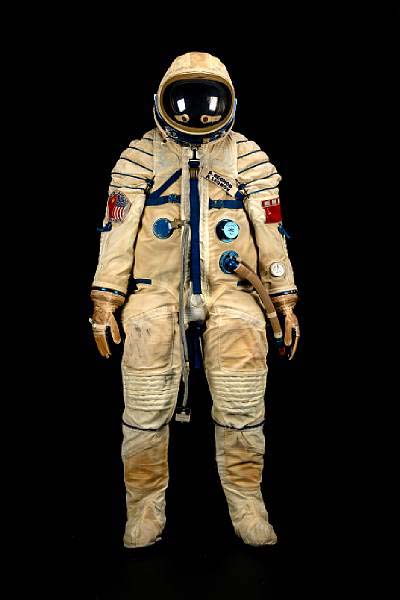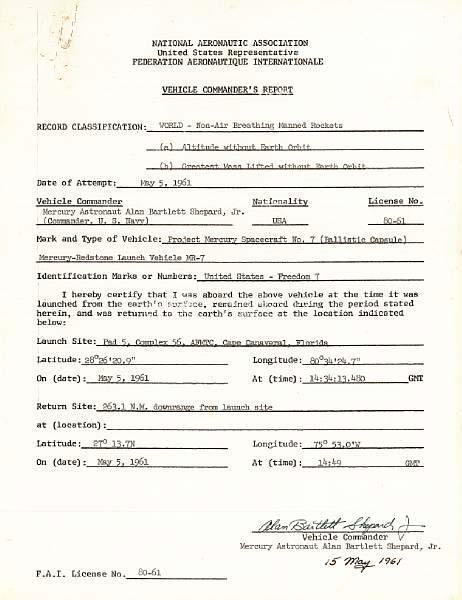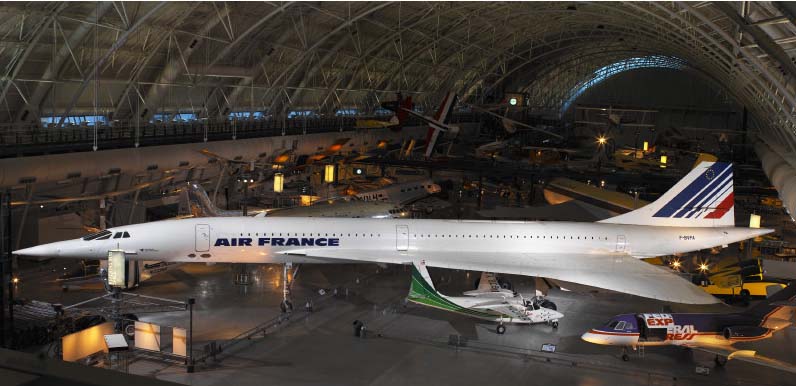It’s Fun to be Rich
On May 5, 2011, Bonhams auction house will hold its annual space history sale. (The date commemorates the 50th anniversary of Mercury astronaut Alan Shepard’s suborbital flight in Freedom 7.) Some 250 items are up for grabs, a few coming from the Forbes Collection, others from the personal collect…

On May 5, 2011, Bonhams auction house will hold its annual space history sale. (The date commemorates the 50th anniversary of Mercury astronaut Alan Shepard's suborbital flight in Freedom 7.) Some 250 items are up for grabs, a few coming from the Forbes Collection, others from the personal collections of various astronauts, and some from the estate of NASA administrator James E. Webb. Here are six of our favorites from the list:
Left is one of Alexei Leonov's spacesuits, this one from the July 1975 Apollo-Soyuz test project. In March 1965, cosmonaut Leonov made the first spacewalk in history, beating American Ed White by almost three months. Floating outside his capsule for 10 minutes, Leonov felt, he writes, "like a seagull with its wings outstretched, soaring high above the Earth."
On July 17, 1975, the final Apollo spacecraft docked with its Soyuz counterpart, and the two commanders, Tom Stafford and Alexei Leonov, shook hands through the open hatch of the Soyuz, symbolically ending the space race. Bonhams' catalog notes that "Leonov wore this space suit during the docking operations, and during launch and re-entry. The Sokol-K suit was categorized as a 'rescue suit' since it was not suitable for EVA use, but was designed to protect the wearer in the event of spacecraft depressurization.... The Sokol-K was first used on the Soyuz 12 mission in 1973 in response to the loss of the Soyuz 11 crew whose spacecraft depressurized during re-entry." The suit comes from the Forbes Collection, and is estimated to fetch a whopping $100,000 to $150,000.

Lot 34, right, is none other than the certificate from the Fédération Aéronautique Internationale confirming astronaut Alan Shepard's May 5, 1961 flight.
In order to qualify for the record of manned spaceflight, the FAI (the governing organization for aeronautical world records) decided that the pilot had to take off and land in the same vehicle. When Yuri Gagarin re-entered Earth's atmosphere on April 12, 1961, he ejected from his spacecraft, as planned, and landed separately by parachute. Gagarin's ejection was covered up by Soviet authorities, however, and the truth wasn't discovered until 1971, by which time the FAI had certified Vostok 1 as the first successful manned spaceflight.
The document at right confirms records set by Shepard in the "non-air breathing manned rocket" category: (a) altitude without Earth orbit, and (b) greatest mass lifted without Earth orbit. The document is estimated between $8,000 and $12,000.

Who could forget the story of Number 65, also known as HAM the chimp? HAM (his name was an acronym derived from Holloman AeroMedical Research Laboratories, where he was sent for training) was one of six chimpanzees-in-training. On January 31, 1961, the little guy flew 157 miles into space, and reached a maximum velocity on his suborbital flight of 5,857 miles per hour. This brass disc, lot 18, is expected to bring between $2,000 and $4,000.

Below is what may be the largest model airplane in the world, a model of the Aérospatiale-BAC Concorde. That's right, it's 50 percent scale, approximately 102 feet long, with a 42-foot wing span, and is estimated to weigh 24,000 pounds.
Bonhams' catalog notes that in 1996, British Airways commissioned the Texas firm L&L Tooling to build this model. "The cost of the model is believed to been $980,000. It was transported to New York City on five trailers, and assembled in situ by a local sign company, four stories up atop the Times Square Brewery on 42nd Street.... At night it was lit from inside.... The model was taken down in 2001, when the Brewery building made way for a tower block. Initially BA planned to reuse the Concorde model in a different site, but it ended up being transferred to the Cradle of Aviation Museum on Long Island, where it has remained, largely undisturbed, for the last decade." If you'd like your own Concorde, be prepared to shell out $100,000 to $150,000.

Maybe you'd like to have both air and space represented in your yard. Why not add this full-scale Saturn V F-1 engine model, left, to your landscape? This 19-foot-tall model was built for the 1964-1965 World's Fair, held in Flushing Meadows, Queens. Bonhams' catalog notes that "At the fair was a Space Park which featured scale models of Gemini-Titan and Mercury-Atlas rockets, the Mercury spacecraft Freedom 7, an Apollo CSM and LM, and the SI-C first stage of the Saturn V, complete with its five F-1 engines. In the decades following the Fair, most of the models remained in place. In the early 2000s, the New York Hall of Science expanded into the Park, tidying up, and restoring the models. The Saturn V first stage was dismantled, and its model F-1 engines were distributed between several museums."
Interested buyers beware: the model is being sold in situ, and is currently located in Garden City, New York. The winning bidder will have to remove the model from its current location no later than July 5. The estimate is $15,000 to $25,000, plus the cost of removal and shipping.

Looking for something more historic? How about a early rocketry manuscript by none other than Konstantin Tsiolkovsky, the man who invented space travel?
This eight-page manuscript, dated 1912, is titled "Latest thoughts regarding construction of jet devices, in the work The Exploration of Cosmic Space by Means of Reaction Devices." Tsiolkovsky is considered, along with Hermann Oberth and Robert Goddard, to be one of the founding fathers of rocketry and spaceflight, and is said to have inspired both Wernher von Braun and Sergey Korolyov.
Beneath the rocket sketch Tsiolkovsky has written, "Certainly many are frightened by this progressive idea , but life itself will make mankind do everything possible to solve this problem. The conquering of solar space is a necessity dictated by the experience of all history of mankind."
The manuscript comes with an authenticating letter from the director of the Tsiolkovsky Museum in Kaluga, Russia, and is expected to bring $12,000 to $18,000.